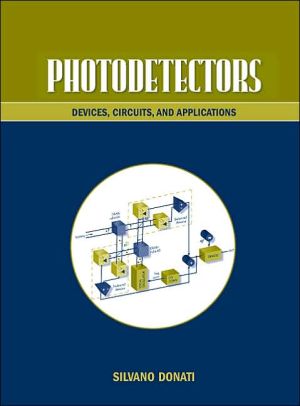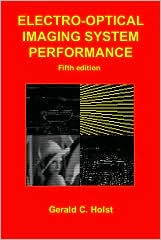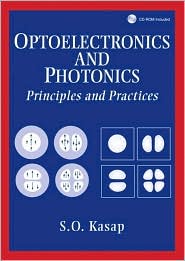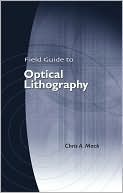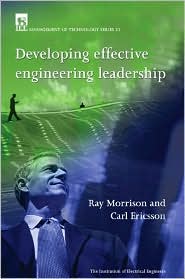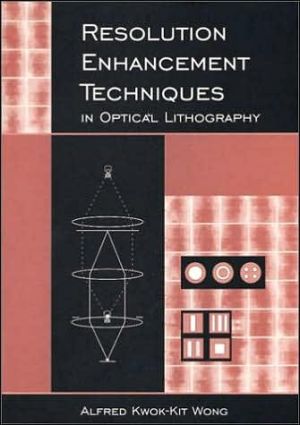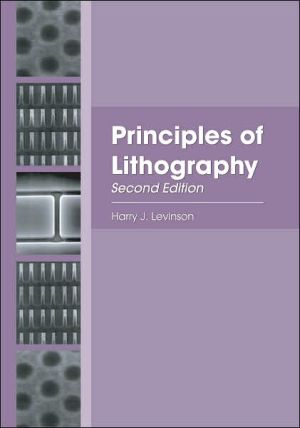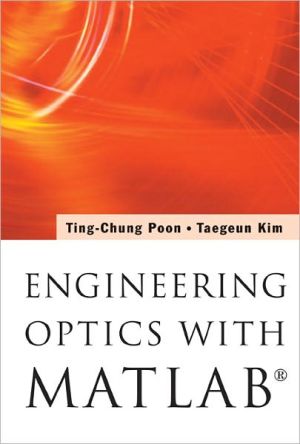Photodetectors: Devices, Circuits and Applications
2033G-2\ The complete guide to photodetection\ Today's optoelectronic devices rely on accurate detection of light sources across the spectrum. This comprehensive guide surveys single-point devices and their image counterparts covering the range from UV to far IR. Basic operations, performance parameters, and special features are presented in the context of application circuits. Special attention is given to issues of sensitivity and noise limits. The devices surveyed include:\ \...
Search in google:
2033G-2The complete guide to photodetectionToday's optoelectronic devices rely on accurate detection of light sources across the spectrum. This comprehensive guide surveys single-point devices and their image counterparts covering the range from UV to far IR. Basic operations, performance parameters, and special features are presented in the context of application circuits. Special attention is given to issues of sensitivity and noise limits. The devices surveyed include: Photomultipliers Semiconductors, photodiodes, avalanche devices, and phototransistors Thermal devices and solar cells Image detectors and CCDs Concluding chapters deal with coherent detection and advanced techniques, while appendices offer convenient reference materials for key principles. Photodetectors: Devices, Circuits, and Applications is a useful reference for working engineers and an ideal sourcebook for university-level courses.
Preface\ This book is an outgrowth of the lecture notes of a two-semester course in optoelectronics, which I started to give in 1976 at the University of Pavia. The lecture was given to electronic engineers in their final year of the MS curriculum. Through the years, I have rewritten the text several times, enlarged the scope, added data useful for design, and included new results coming from both by own research and new findings by others. Thus, the present book has become more similar to a treatise than to the original lecture book. I have tried to use a modern teaching approach, starting with simple ideas and developing a wide range of topics, so that this book can serve as a textbook in basic photoelectronics and also be profitable to the designer engineer looking for practical hints and solutions. Mathematical derivations are kept to a minimum, and readers interested in applications may skip them and go directly to the results, which I have tried to make useful by comments and examples. Complementary information and advanced considerations appear in reduced character size and may be skipped in a first reading. In the appendixes, I have collected some material either necessary as an introduction or of practical relevance for applications.\ In the paradigm of optoelectronics, light is generated by a source - frequently a laser - which propagates in a medium, or interacts with it, and then comes to a detector where the desired information is converted back to an electrical signal. In the signal-to-noise budget, increasing the laser power by a factor of K is equivalent to reducing the detector noise by K - a simple statement whose importance is sometimes understated, but one that should always be kept in mind in order to optimize system performances of the photodetector.\ Photodetectors are the forerunners of any frontier in optoelectronics. When an unusual spectral range or a new frequency band is explored, photodetectors are first to establish a tool for handling the optical signal. Then, optical components and laser sources follow. Thus, the excitement of the discovery comes more frequently with photodetectors than with the other optoelectronic devices. Figures P-1 through P-4, on the following pages, show just a sampling of the big achievements of photodetectors.\ This book covers the very basic background of photodetection that should be mastered by any scientist or designer active in modern optoelectronics. To give an order-of-magnitude idea, in the optoelectronics-oriented curriculum offered at our engineering facility, one course is devoted to lasers, one to photodetection, one to fiberoptics communication, and one to electrooptics instrumentation.\ This book is structured as follows. All types of photodetectors of practical importance covering the spectral range from UV to far IR are considered, first treating singe-point devices and then their image counterparts. For each photodetector, we begin by understanding the principle of operation. We then discuss parameters of performance, basic characteristics, special features, and application circuits with schematic details and design hints. Finally, we end up analyzing in special detail noise, which is the ultimate limit of sensitivity performance - the goal to be approached in any well-designed application.\ Commenting on the list of contents, we start with the photoemissive (i.e., vacuum) devices, historically the first and presently in a technical decline, but still unparalleled in allowing the powerful single-photon counting regime actually exploited in several scientific applications. After a chapter on photocathodes and vacuum phototubes, in Chapter 3 we consider the system aspects of photodetection, stressing the importance of an internal gain mechanism in photodetectors, and also clarifying the regimes of detection as well as introducing the figures of merit.\ Chapter 4 is fairly long and is devoted to photomultipliers because of their importance in a variety of applications. We present the basic theory, analyze the response in time and frequency domain, and discuss a number of applications.\ Chapter 5 deals with semiconductor photodetectors and related devices, including the family of photodiodes, avalanche devices, phototransistors and photoconductors, and solar cells. In addition to physical aspects and electrical characteristics, we treat the application circuits, elucidating the design of front-end circuits and discussing their performances in a number of well-established applications, from instrumentation to large-bandwidth communication.\ Infrared techniques and thermal detectors for non-contact temperature measurements and thermal-image pickup are treated in Chapters 6 and 7.\ Chapter 8 is devoted to coherent detection and advanced techniques in photodetection, covering topics not usually found in textbooks and demonstrating how photodetection is far from being a completely explored field.\ Chapter 9 treats image-sensing devices, including vidicon tubes, intensified image-tubes, and the CCD family. Finally, a series of appendixes is added to complement the text and deal with basic topics such as radiance invariance, eye sensitivity and color description, thermal and quantum noise, details of calculations omitted in the text, and more.\ In regards to system aspects, the sensitivity/bandwidth tradeoff and the quantum/thermal regime of detection considered in Chapter 3 might also have been placed at the beginning of the book or merged in Chapter 8, but in my teaching experience I find they are best discussed soon after the very first description of detectors and their electrical parameters. Also, I have included a short chapter on solar cells because these devices are closely related to photodiodes and share the same technological problems and development issues (besides belonging to the optoelectronic engineer in systems deployment).\ Thus, this book offers a rather wide coverage of photodetectors from the point of view of devices, circuits, and applications. I have tried to make each chapter self-contained and readable in itself so that it can be useful as a reference for anyone interested in solving his/her particular photodetection problem.\ In my experience from the Italian edition, the text can be used for a two-semester course as a whole, or for a one-semester course with several different choices of arguments or stress upon devices, circuits, or system aspects. I have also used it for a series of seminars to Ph.D. students in an advanced course on photodetection and noise. I think that this book will also be a useful reference and aid for technical people and professionals involved in the design of photodetection systems. Engineers and physicists may use it as a guide in choosing the best solution and in evaluating the achievable performances in a photodetection problem. Designers should find it useful because of the abundant reference data on actual photodetectors, as well as for the practical circuits discussed.\ For a full understanding of the technical content, this book requires as a prerequisite the basic courses in electronic devices and circuits, and the very fundamentals of semiconductors and noise. In regards to semiconductors, an excellent introduction is provided by Bhattacharya's book Semiconductor Optoelectronic Devices (Prentice Hall). Of course, many topics and ideas can be gathered from the material presented in this book as well, though with a more modest background.\ In closing, I wish to thank the numerous researchers and students of mine for their help in collecting the text of my lectures and in suggesting corrections to the earlier versions. Among all, I am pleased to acknowledge my former Ph.D. student T. Tambosso, who collected and edited the first version with great care and suggested several major improvements to the content, incorporated since the first Italian edition.\ I also wish to thank professor Joe C. Campbell of the University of Texas and professor Sergio Cova of the Polytechnic University of Milano for their encouragement and suggestions.\ In my scientific career, I have found photodetection to be a very exciting and rewarding field of study. If I can convey to the reader the same enthusiasm and satisfaction, I will be amply rewarded for my efforts in writing this book. So, I dedicate this book to the brilliant young students who will become the scientists of tomorrow.\ Silvano Donati Pavia, Italy email: donati@ipvsm6.unipv.it\ June 1999\ Figure P-1\ The SuperKamiokande facility employs 11,200 giant PMTs (photomultipliers, see Chapter 4) valued at about 80 million US$, and paving the walls of a 40-meter diameter tank of water that probes the most elusive nuclear particles-neutrinos (courtesy of ICRR, University of Tokyo).\ Figure P-2\ Aboard the Sky Telescope, a 5000 x 5000 pixel CCD (charge coupled device, see Chapter 9) has provided this 10-day integration picture of deep sky (Hubble Deep Field Survey). Faintest spots are 30th magnitude galaxies, estimated to be 8 billion light-years away (courtesty of R. Williams and the HDF Team ST Scl, and NASA).\ Figure P-3\ Infrared thermography (see Chapter 6) unveils the blackbody thermal emission in the middle and far infrared (see Appendix A1), providing a non-contact map of the temperature differences, a powerful diagnostic tool in industrial, biomedical, and military applications (courtesy of Avio-Nippon Avionics Co.).\ Figure P-4\ A streak-camera based on an image converter tube (see Chapter 9) allows one to observe (a) a sequence of pictures at nanoseconds frame-rate, or (b) to resolve optical-pulse details down to a few picoseconds. By courtesy of Imacon Ltd, UK.
PrefaceCh. 1Introduction1Ch. 2Photocathodes5Ch. 3Detection Regimes and Figures of Merit37Ch. 4Photomultipliers47Ch. 5Semiconductor Photodetectors109Ch. 6Thermal Detectors and Thermography215Ch. 7Solar Cells233Ch. 8Photodetection Techniques249Ch. 9Image Detectors295App. A1Spectral Ranges and Measurement Units357App. A2The Invariants of Radiometry369App. A3Eye Performance381App. A4Noise Revisited393App. A5Complementary Information for Junction Photodiodes399App. A6Calculation of the APD Response407App. A7Source of Information on Photodetectors411Index413
